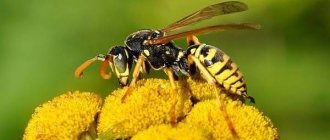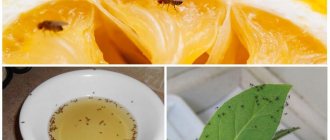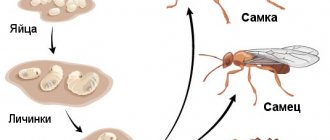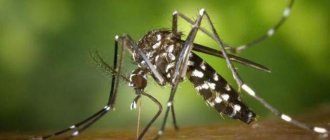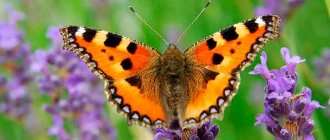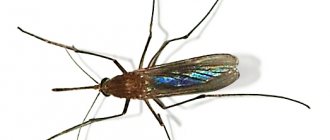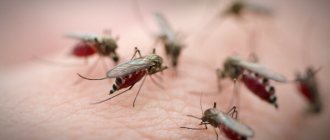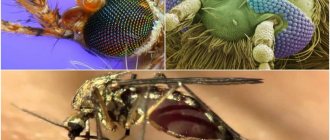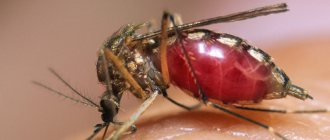- Wild animals
- >>
- Insects
Everyone associates the ladybug There is probably no person who has not held it in the palm of his hand at least once. There are many poems dedicated to this little insect, which kids read every time it fell into their hands. Some consider it a symbol of good luck, others consider it an assistant in the fight against harmful insects in gardens and vegetable gardens - it evokes sympathy among everyone.
Origin of the species and description
Photo: Ladybug
The ladybug is a very common ancient arthropod insect all over the world, a representative of the order Coleoptera and the ladybird family. This insect received its scientific name Coccinellidae due to its scarlet color. The bug lives almost everywhere. It was popularly nicknamed the ladybug because of the poisonous white liquid or “milk” that the insect secretes to scare away predators, and the ladybug because it helped in the fight against aphids and other pests to preserve the harvest, had a gentle disposition, and did not cause any harm to humans. .
Video: Ladybug
In Germany and Switzerland, the tiny insect is called St. Mary's bug, in South America - St. Anthony's ladybug. There were many legends about this little bug; it was said to have the ability to influence the weather.
Interesting fact: Even in ancient times, the Slavs considered the ladybug to be a heavenly creature, a messenger of the sun. That is why she was often called “Sunny”. It was forbidden to drive away the insect, so as not to incur bad luck. A bright bug that flew into a home brought blessings.
There are a huge number of varieties of ladybugs: the entire family has more than four thousand species, which in turn are divided into 7 subfamilies and 360 genera. The ladybug differs from other representatives of the family Coccinellidae in the structure of its legs. In the structure of each of them there are three visible and one hidden segment, so they seem to be three-component.
Ladybug: description, structure, characteristics. What does a ladybug look like?
According to the biological classification, the ladybug is an arthropod insect that belongs to the Coleoptera and the family of ladybirds.
The size of a ladybug ranges from 4 to 10 mm. The shape of their body is either round or oval-elongated, flat below and very convex above. The body surface of some types of ladybugs is covered with fine hairs. The structure of their body includes a head, a pronotum, a chest consisting of three sections, an abdomen, wings with elytra and three pairs of paws.
The ladybug's head is small (although in some species it may be slightly elongated), it is motionlessly connected to the anterior chest. But the ladybug's eyes are relatively large. The insect's antennae, which consist of 8-11 segments, are highly flexible.
The ladybug's pronotum is convex, has a transverse structure and a notch at the anterior edge. On its surface there are often “signature” spots of different shapes.
Thanks to the presence of three pairs of paws, the ladybug can move quite quickly both on the grass and along plant stems. The abdomen of ladybugs consists of five or six segments, which are covered from below by sternites (segmental semirings).
Appearance and features
Photo: Ladybug in nature
The size of the ladybird ranges from 3.5 to 10 mm. The bug's head is small and motionless. The eyes are relatively large, the antennae of 8-11 segments are very mobile and flexible. The body of a ladybug consists of a pronotum, a thorax, three pairs of tenacious legs, an abdomen, and wings with elytra. The insect's pronotum is convex, often with spots of various colors and shapes. Bugs fly using the back pair of wings, while the front ones, in the process of evolution, were formed into strong elytra, which now serve as protection for the main pair of soft wings. Not all ladybugs have the usual scarlet color and black dots on their backs.
From all their diversity, the following varieties can be distinguished:
- two-spot - a bug with a body size of up to 5 mm. It has a black pronotum, and the bright red elytra are decorated with two large black spots;
- seven-spot - has a size of 7-8 mm, widespread throughout Europe. On its red back there are two white spots and 7 black ones;
- twelve-spotted - a red or pink bug with an elongated body shape and 12 black spots;
- with thirteen spots - distinguished by an elongated body and a dark brown or red-brown back, the spots can merge with each other;
- fourteen-pointed - a characteristic feature of the elytra is yellow or black;
- seventeen-spotted - the size of the insect is no more than 3.5 mm, it has a bright yellow back with black dots;
- blue - found only in Australia;
- ocellated - characterized by a large body size up to 10 mm. All black dots on the red or yellow back of the insect are framed by light rims;
- pointless - their size does not exceed 4.5 mm, they have a dark brown back color, their body is covered with fine hairs. They are extremely rare in nature.
Not all varieties of ladybug benefit people. The alfalfa beetle is a pest for many agricultural species. crops, it actively eats young shoots, destroys the harvest of beets, cucumbers, and so on. The bug is distinguished by its small size, up to 4 mm, it has a red back strewn with 24 dots.
External features
An adult specimen measures from 4 to 10 mm. The body shape of these insects is flat below, round, oval and highly convex above. Some species have a surface covered with miniature hairs. The body has the following structure:
- head;
- pronotum, consisting of three sections;
- breast;
- paws - three pairs;
- abdomen;
- elytra and wings.
The head is miniature in size, articulated with a fixed prothorax, and is sometimes elongated (depending on the type of insect). The eyes are large, the antennae include from 8 to 11 segments, and are quite flexible. The pronotum is transverse in structure, convex, and has a small notch in front. Often, spots of various shapes are found on top. The metathorax is almost square when compared with the elongated mesothorax and prothorax.
There are a total of 6 paws of moderate length. Each of them has one hidden segment and 3 obvious ones. Using them, the insect is able to move along plant stems.
The abdomen includes from 5 to 6 segments, which are covered with segments in the form of half rings. They are called sternites .
Ladybugs use their two hind wings to fly. Over the long centuries of evolution, the front ones have turned into hard elytra. Now they play the role of a protective shell while the bug crawls along the ground. Cantharidin, which is a yellow, caustic liquid, is used by adults to repel birds and other predators. It has a specific smell and works quite effectively.
Also, the bright colors have a frightening effect on potential ill-wishers. The color of the insect can be deep red, yellow, dark blue, black or brown. The spots on the skin can vary in configuration and be red, white, or yellow.
In some species, the spots merge, forming peculiar patterns, while in others they are completely absent. Often, a pattern on the pronotum can indicate the sex of the beetle.
Almost none of the insects and animals are capable of causing harm to representatives of the group in question. However, dinocampuses are an exception to the rule. They are not afraid of toxic hemolymph or bright colors. These insects attack adult cows and lay their own eggs in their bodies. As these parasites develop, they destroy their host .
Where does the ladybug live?
Photo: Ladybug in Russia
The ladybug is found in almost all, even the most remote corners of the globe, with the exception of northern latitudes. The optimal temperature for this bug is not lower than 10 degrees Celsius.
For accommodation they choose:
- forest edges;
- meadows and steppes;
- gardens and vegetable gardens;
- can be found in city parks.
With the onset of cold weather, some ladybugs fly to southern latitudes for wintering. They fly very high, during rain or strong wind they fall to the ground and wait out the bad weather. A large number of beetles die during these flights, especially when they accidentally land or fall into bodies of water from which they cannot get out. Sometimes you can see river banks literally painted red due to the huge number of dead insects.
That part of the ladybugs that do not leave their place of residence for wintering in warm regions gathers in huge scarlet colonies, which can number millions of individuals. They hide in secluded places: under the bark of trees, stones, leaves, and fly into living quarters. They spend the entire winter in a state of torpor and only come to life with the first warmth.
Interesting fact: Ladybugs always hibernate in one place, and then return exactly to the area from which they came. Even young animals find their way to wintering on their own.
What does a ladybug eat?
Photo: Miraculous ladybug
The ladybug is a real predator among insects. Thanks to the structure of its jaw and the functioning of its digestive tract, it is able to hunt other insects and then quickly digest them. There are varieties that choose plant food: pollen, mold, flowers and leaves.
The diet of predatory species includes mainly:
- aphids in huge quantities;
- spider mites;
- caterpillars;
- insect larvae;
- butterfly eggs;
- some do not even disdain the larvae of Colorado beetles.
Ladybugs eat a lot, they are always hungry, especially their larvae. Each individual can easily destroy more than a hundred aphid larvae per day. Having large eyes, insects mainly use only their acute sense of smell in search of food.
The bugs do not hunt their victims, but only slowly, leisurely move through the foliage in search of food, and when they find a colony of aphids or a clutch of eggs of pests, they linger for a long time in this place for a meal until they destroy it completely. That is why the ladybug is a welcome guest on any personal plot, agricultural fields with crops, and in the garden. They are even specially bred at special enterprises and then distributed over cultivated lands with the help of agricultural aviation. Unfortunately, some varieties of these bugs, mainly living in Asia, cause damage to crops.
Now you know what ladybugs eat. Let's see how to breed these beautiful insects.
Insect nutrition
The main feature of the ladybug for every summer resident is her love for aphids. More precisely, eating this pest. Interestingly, in search of its favorite food, an insect can cover a considerable distance. Adults of these nimble bugs can eat up to 150 aphids per day.
Some species include the following types of insects in their diet:
- whiteflies;
- scale insects;
- spider mites;
- Mealybugs.
There are even several species that eat fungal spores. Insects also love plant pollen and flower nectar.
Features of character and lifestyle
Photo: Red ladybug
All varieties of ladybugs choose an isolated lifestyle and form groups only for flying to warm regions or wintering in a secluded place. These huge groups can number up to 40 million individuals. You can also notice clusters of bugs during their mating season. All these bugs do not hesitate to feast on the larvae of their relatives, but only in the absence of a sufficient number of aphids and other food. But there are varieties of ladybugs that purposefully destroy their fellow creatures.
Interesting fact: The yellow marbled ladybug was specially bred as an effective biological weapon against agricultural pests, but it was because of it that some varieties of these bugs were in danger of complete extermination, since the marbled ladybug destroyed them in huge quantities along with other insect pests .
These insects are active all day, they slowly crawl from one plant to another in search of food. Given enough food, the lifespan of some individuals can reach two years or even more, but this happens extremely rarely. The main part dies much earlier, before reaching the age of one year, and there are many reasons for this: from lack of nutrition to environmental pollution.
Reproduction
Mating always occurs in clusters before dispersal. Since geneticists have established for many species a sharp decrease in fertility during inbreeding, it is clear that with large aggregations the chance of such inbreeding becomes negligible.
It is also noted that the spring awakening of cows coincides with the active development of reproductive products. But all these considerations do not explain why clusters are present or absent even in the same population. It seems to us that the correct explanation should be sought in the historical formation of the group. The family of ladybirds is clearly of tropical origin and originally must have fed on coccids or mites, as is still the case in the tropics, where aphids are few in number.
On the contrary, in countries with cold winters, aphids are usually abundant and coccids are rare (in the subtropics, ladybugs feed on both aphids and coccids). With the cooling of the climate during a certain geological period, probably in the Paleogene, some populations of aphidophagous ladybugs were forced to adapt to colder winters, but the abundance of food led to their massive reproduction. This, in turn, could contribute to the formation of winter aggregations, the main benefit of which was protection from the cold. Subsequently, more frost-resistant species appeared, populating both the boreal zone and high mountains.
Dispersing south along mountain ranges, some species remained high-mountain. Others began to descend into the valleys in the spring, where food was more plentiful for them. But they retained the ability to return to their original biotope when environmental conditions in the valleys became unfavorable. Subsequently, many of these species, thanks to their high ecological plasticity, secondarily adapted to existence in the plains and changed their wintering conditions.
The above data demonstrates the ease with which many cows adapt to a wide variety of environmental conditions.
Social structure and reproduction
Photo: Ladybugs
All ladybugs are solitary. Only during the mating season do males use a specific smell to look for a female to mate with. This usually happens in early spring and soon the female lays up to 400 eggs on the lower surface of the leaves. They are oval in shape and can be yellow or orange. The female chooses a place for laying closer to the aphid colony so that the offspring are provided with food. This is the only manifestation of caring for their offspring. Most often, she dies after this.
After a couple of weeks, the larvae appear. Their body is covered with hairs and has a variegated color; the pattern combines yellow and brown spots. In the first days, the larvae eat the remaining egg shells and unfertilized eggs, then go in search of aphids. The stage lasts from 4 to 7 weeks, after which the formation of a pupa occurs, which then attaches to the edge of the leaflet, where its further transformation occurs.
At the end of it, after 8-10 days, the skin peels off from the pupa like a stocking to the end of the abdomen. A full-fledged individual ladybug appears, which gradually acquires its usual bright color. At first, its elytra are pale in color; by this feature one can easily distinguish an adult from a young one. Young bugs are ready to reproduce at 3 months of life, some only at six months - it all depends on the quality of nutrition and environmental conditions.
Natural enemies of ladybugs
Photo: Ladybug in flight
The ladybug in the wild does not have many enemies due to the specific poisonous white secretion that it secretes. If a bird even once tastes a brightly colored bug, its bitter taste will discourage it from hunting for it for the rest of its life. Many insects quickly die from the ladybug's hemolymph.
The main enemy of ladybugs is dinocampus, a small winged insect that kills adult ladybugs and even its larvae by laying its eggs inside their bodies. As they develop, they feed on the body of their victim, and then the empty shell simply bursts, like in some famous horror films. Dinocampus finds bugs by their protective smell, with which they successfully scare away their other enemies. Parasites are capable of significantly reducing the number of ladybugs in a short period of time.
The active use of various chemicals for cultivating fields and the general depressing state of the environment also have a strong influence on the reduction in the population of these bright bugs. In some countries, there is a trend of replacing chemicals with natural, environmentally friendly methods of pest control. Ladybugs are bred in huge quantities and are even a national export item.
Ladybugs maintenance and care in winter
The dots do not indicate age, but what species the cow belongs to: two dots - two-pointed, five dots - ... (five-pointed), seven dots - ... (septipotent)
And now, attention - game! (Children are divided into three teams - two-, five- and seven-point ladybugs, each team must find an image of their ladybug in the group room and stand in a circle around it. The team that does this faster wins)
But what happened to ladybugs in one city, where black poisonous smoke poured out of the chimneys and the air was dirty. All the ladybugs in this city have changed color. From red they became black. When people noticed this, they got scared and took immediate action. After the air became cleaner, the cows turned red again. It’s good that our Crimean ladybugs are red and yellow, not black. Does this mean what kind of air do we have? (Children's answers). Clean. It would be nice if it were always like this.
Questions:
1. Why don't birds eat ladybugs? 2. What other method of protection do ladybugs have? 3. Who do ladybugs themselves eat? 4. How do you say “doll”, “sun” in Ukrainian? 5. What do you know about aphids? 6. How do ladybugs find aphids? 7. How are their babies born? 8. What behavior of ladybugs is a mystery to scientists? 9. Why do gardeners love ladybugs? 10. Do you and I have anything to thank these bugs for? 11. Why did the bug get its name? 12. What is another name for a ladybug? 13. How can you determine the cleanliness of the air by the color of ladybugs? 14. What kind of ladybugs are found in Crimea?
Handmade “Ladybug” (painting half of a large walnut shell to look like a “ladybug”).
Children's works on the theme "Ladybug"
Download lesson notes “Ladybug”
News and society
Population and species status
Photo: Ladybug
The population of ladybugs has decreased significantly due to active control of aphids. These little bugs simply have nothing to eat. Due to rapid reproduction and a small number of natural enemies, the population is able to recover in a short period of time if food is available. The status of the species is currently stable. At this time, only some rare varieties of these beetles are under threat of complete extinction, for example, the Australian blue and pointless ones.
Interesting fact: In search of food, a hungry ladybird larva can travel up to 12 meters, which is a huge distance for insects.
Trying to restore the population of beneficial bugs artificially, people sometimes, even with their good intentions, on the contrary, cause significant damage to it. In recent years, millions of individuals, specially bred ladybugs, have been released into their natural habitat, which, due to obvious mutations, changed the nature of their feeding and chose their own relatives as victims. All this caused the death of a huge number of beneficial bugs in all European countries. A thoughtful approach to this problem is needed without undue interference in the natural course of processes in nature.
What do ladybugs eat at home and why are they bred?
Some gardeners and businessmen raise ladybugs at home in transparent plastic containers, make very small holes in the lid, or cover them with gauze or mosquito net and feed them with a mixture of yeast and sugar. Why do they do this? To then release them on your site to combat aphids or for sale to other gardeners.
To create comfortable conditions for the life and reproduction of ladybugs, small plants are planted in their housing, which are populated by aphids, so the ladybug finds itself almost in a natural habitat, can hunt and lead an active lifestyle. In captivity, ladybugs reproduce better than in nature, and at the same time, adult individuals remain living with their faces at the same time.
When there are enough ladybugs in the container, they are put up for further sale; most often, gardeners buy them in large quantities, and keep the larvae and a few insects for themselves so that the cycle of ladybugs does not end.
Ladybugs are insects popular due to their bright colors. The best habitat for ladybugs is the wild, but if you are lucky enough to find an insect near your home and want to take care of it, it is not difficult to do so - provide the ladybug with food, water and recreate the natural conditions of its habitat.
